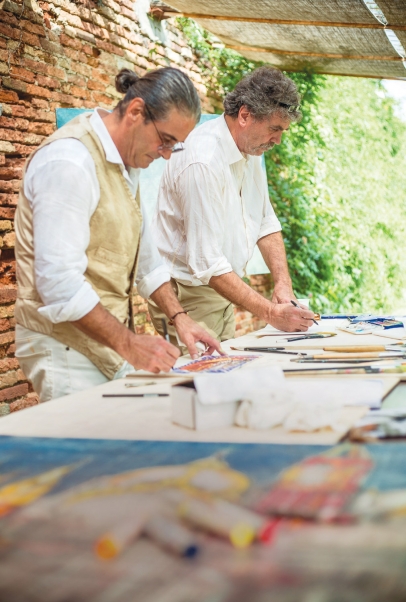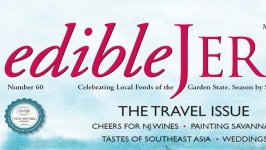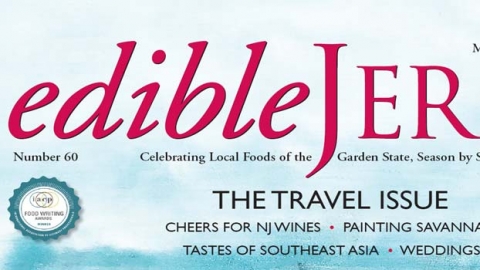Two Italian Artists and an Orange Tree in Savannah
A jar of pickled pigs’ feet and a kettle of boiled peanuts sat near the cash register at a convenience store along Skidaway Road, as if pigs’ feet and peanuts were an impulse buy.
Across Skidaway Road, two brothers from Italy painted a collection of modern frescoes at Cohen’s Retreat, a boutique hotel and restaurant about 20 minutes from the historic center of Savannah. Roberto and Rodolfo Guarnieri had commandeered a light-filled workroom in the back. Large panels of fresh-cut plywood rested atop sawhorses, where the brothers worked early last spring to complete 22 pieces in two weeks. Some were variations on the artists’ signature subjects—a wintery reinterpretation of Botticellli’s Primavera, a color-rich version of Brunelleschi’s Duomo, whimsical splays of Tuscan poppies in brilliant hues of indigo and merlot. The brothers worked also to capture scenes of Georgia, painting a brooding avenue of trees at Wormsloe Plantation, a rainbow-colored sea off Tybee Island and an earnest Savannah City Hall, the dome of which they decorated in gold leaf.
A fresco is a work of art painted onto wet plaster; an artist must paint rapidly, before the lime dries. As Roberto likes to say, the fresco takes only minutes, but a lifetime of expertise comes before. In Florence, the brothers work from their studio in the Oltrarno district, just across the Arno River, and the rooftop terrace offers a view of the Duomo and Ponte Vecchio. Their artwork can be found throughout Florence (at the Four Seasons and the Portrait hotels) and has been displayed in galleries and private collections worldwide. A 2019 exhibit is set for the Belmond Hotel Cipriani in Venice.
In Savannah, if the Guarnieri brothers were surprised by convenience- store pigs’ feet, they didn’t let on. In Florence, sandwiches made from tripe have been street food for centuries. Boiled peanuts, however, proved a Georgia specialty the men from Italy couldn’t wrap their heads around. “The pleasure is not enough for the work you have to do,” says Rodolfo.
And so it goes in a city that continues to defy easy classification. Savannah proudly claims to be America’s most haunted—a city of drag queens and former slave traders. Today, the stark divides are evident, even to a casual tourist, between wealth and poverty, whites and blacks, tradition and innovation. Along the cobblestone streets near Forsyth Park, stately antebellum mansions, restored to their architectural splendor, sit next to equally strong-boned structures that remain in ruins, satellite dishes poking through collapsed roofs.
“For me, Savannah’s resistance to change was its saving grace,” writes John Berendt in Midnight in the Garden of Good and Evil. “The city looked inward, sealed off from the noises and distractions of the world at large. It grew inward, too, and in such a way that its people flourished like hothouse plants tended by an indulgent gardener. The ordinary became extraordinary. Eccentrics thrived.”
Savannah in spring is certainly a hothouse; mild temperatures arrive early, the air is quickly rich with the perfume of thousands of competing flowerbeds. And the city is certainly full of delightful characters. The airport cabdriver, a man who just bought a midlife- crisis Mustang convertible, yearns for Jimmy Carter—it seems two lifetimes ago he was president, he says—and believes America’s superpower should be peace. A young, slender man attending a wine tasting dresses impeccably in storybook attire, a crisp military swing coat paired with slim, creased pants and velvet slippers. Everywhere, it seems, eccentricity is revered. It’s evident in the silkiness of an accentuated Southern drawl or in an incongruous table centerpiece, which is a statuette of a shark.
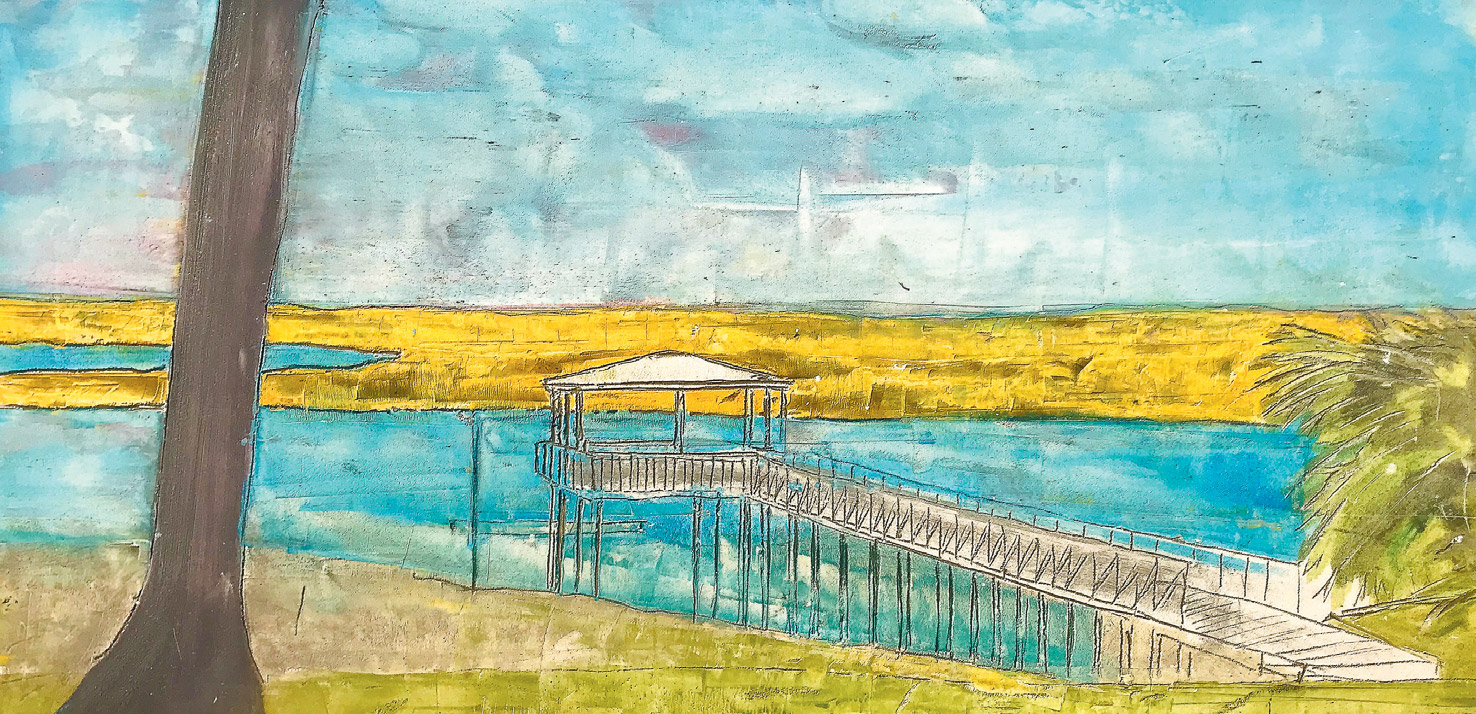
But resistant to change? Savannah today feels emergent, with an undercurrent of itchy, as if residents can’t wait to make a few changes here and there. Storytelling feels important, and stories that were previously subtext, especially those of slavery and race, are pushing their way into the spotlight. Savannah is the city where Martin Luther King Jr. first gave his “I Have a Dream” speech, and today, tours of African-American heritage sites are gaining momentum. Significant sites include one of the city’s oldest black cemeteries, Laurel Grove South, where gashes remain vivid in the whipping tree, and the First African Baptist Church, a stop on the Underground Railroad.
And rather than sealing itself off, the city is looking out, at least occasionally, and inviting in others. Savannah’s fall film festival, which honored Hugh Jackson and Emily Blunt in October, bills itself as the largest university film festival in the nation. The February book festival last year celebrated its 10th anniversary, attracting Colson Whitehead, author of The Underground Railroad, who was the sold-out guest speaker. (Whitehead begins his book in Georgia with the story of a slave on a plantation.) For the upcoming festival, a visit by Nana Kwame Adjei-Brenyah, author of Friday Black, is eagerly anticipated.
Much of the city’s emergent energy is credited to the Savannah College of Art and Design (SCAD), established a mere 40 years ago by a small group including Paula S. Wallace, the current president, who sold her Volkswagen Beetle to help fund it. SCAD has worked with the city to preserve its architecture, gobbling up and renovating neglected buildings, from a synagogue to an armory to a vaudeville playhouse to a department store. To date, 67 buildings have been restored by the college, work that has earned accolades from a variety of historic and architectural organizations. The school enrolls 10,000 art students; that influx alone adds to Savannah’s vibrancy.
Downtown, the city feels animated. H&M, Urban Outfitters and Banana Republic have outposts here, but local businesses also are busy. Paris Market showcases a variety of work by Georgia artisans. Zia Boutique features stunning creations by award-winning jeweler Zia Sachedina, whose unique childhood—split between Savannah and Kenya, with a Japanese-American mother and an East Indian father—continues to inspire his creations. Savannah Bee Company offers Tupelo honey and other products; the beekeepers are based in Coastal Georgia. At Mabel’s Cupcake Emporium, the Famous Mabel, a yellow cake with yellow icing, is as sweet and pure as Sunday afternoons after church.
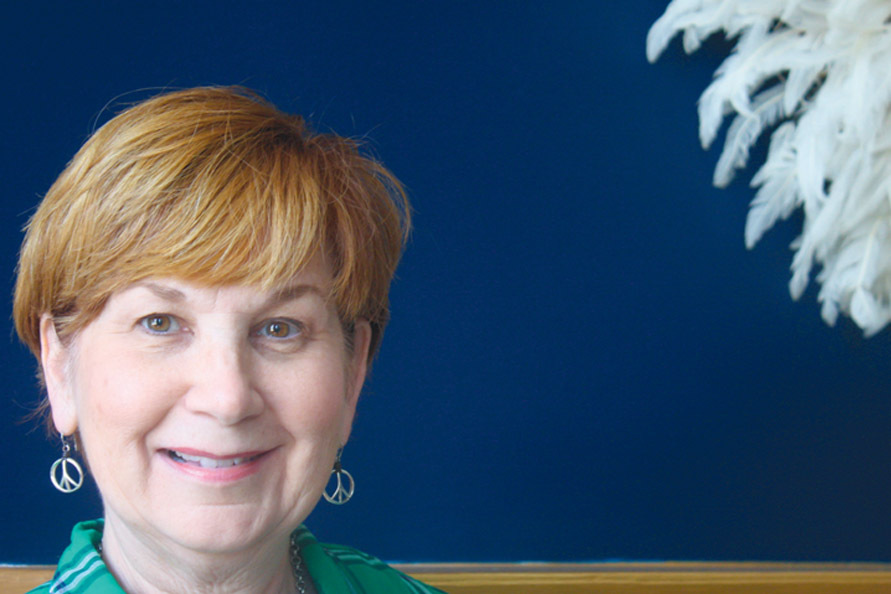
Colleen Smith’s goal is to bring together art, food and community. She considers Cohen’s Retreat to be her canvas.
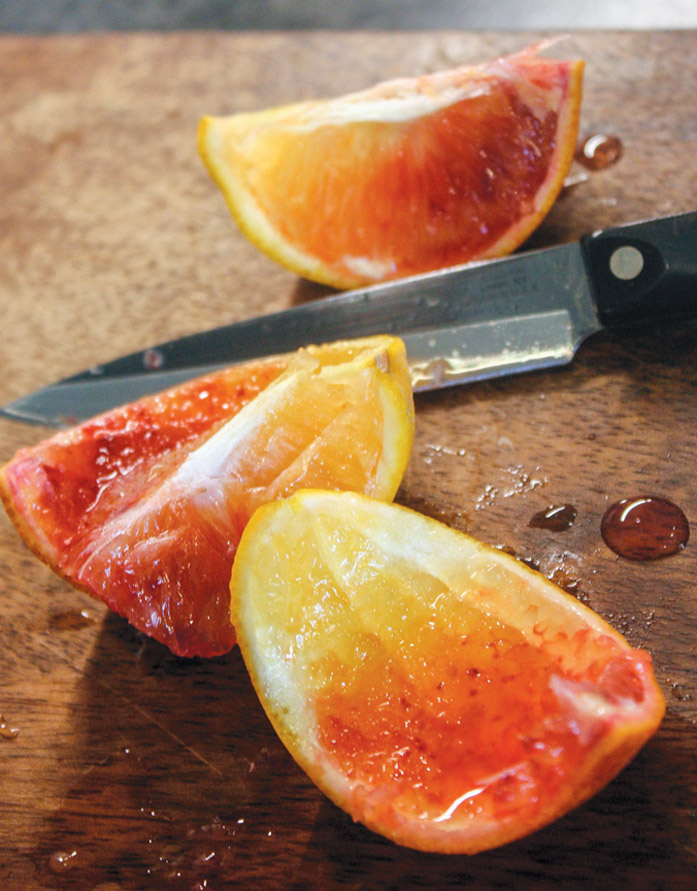

Tomato Pie and a Home for Old Men
Skidaway Road and Cohen’s Retreat, like everywhere in Savannah, seem all the more mysterious because of those ancient oaks, hundreds of years old, trees of grandeur cloaked in a sweeping, dangling garland of Spanish moss. Spend any time in Savannah and you’ll likely hear a story about Spanish moss—how the moss is full of red bugs, and what a surprise those bugs were to Civil War Yankees who used the moss as bedding. Then again, you’ll also hear that the red bug/Spanish moss story is not true—that red bugs come from the earth and that Spanish moss is filled with spiders. The distinction seems puzzling. A bug’s a bug either way.
Cohen’s Retreat was built in the 1930s as a home for old men, so they would not die alone. It was funded by the estate of Percival Randolph Cohen, a philanthropist and bachelor. The retreat closed in the 1980s but housed Olympic athletes in 1986, including the track and field team from Uganda. In 2011, Colleen Smith bought the property at auction. By then, the retreat had been vacant for years, and the cottages out back were filled with squatters; transactions— drugs and prostitution—were prevalent. Yet, Smith stood nervously for hours outside the courthouse during the sheriff ’s sale. Growing up, she, along with thousands of other local children, had been trundled for years from schools and churches to sing and perform for the seniors during the holidays. “I was convinced that everyone there had come to buy Cohen’s Retreat.”
In renovating, Smith kept the old-man stuff; the retreat is now decorated with canes, alarm clocks and shoe horns. The silver serving utensils have become wall décor. Today, Cohen’s Retreat is a popular wedding venue, a spot for ladies’ luncheons and local gatherings. Smith’s goal is to bring together art, food and community, and she considers Cohen’s Retreat to be her canvas.
In the restaurant, specialties include a tomato pie with an impossibly flaky crust. Tomato pie is a Southern specialty and a sign of hospitality, a savory pie made with tomatoes and cheese—nothing like the beloved Jersey tomato pie, aside from similar animated debates over which recipe is best. Smith also likes to feature oysters from nearby Pin Point; she remembers a childhood of neighborhood get-togethers with tables of steamed oysters, tabasco sauce and Saltines.
Smith hopes her retreat will help attract visitors outside Savannah to the Wormsloe Historic Site, to Moon River and to Pin Point, a rural community founded by freed slaves after the Civil War.
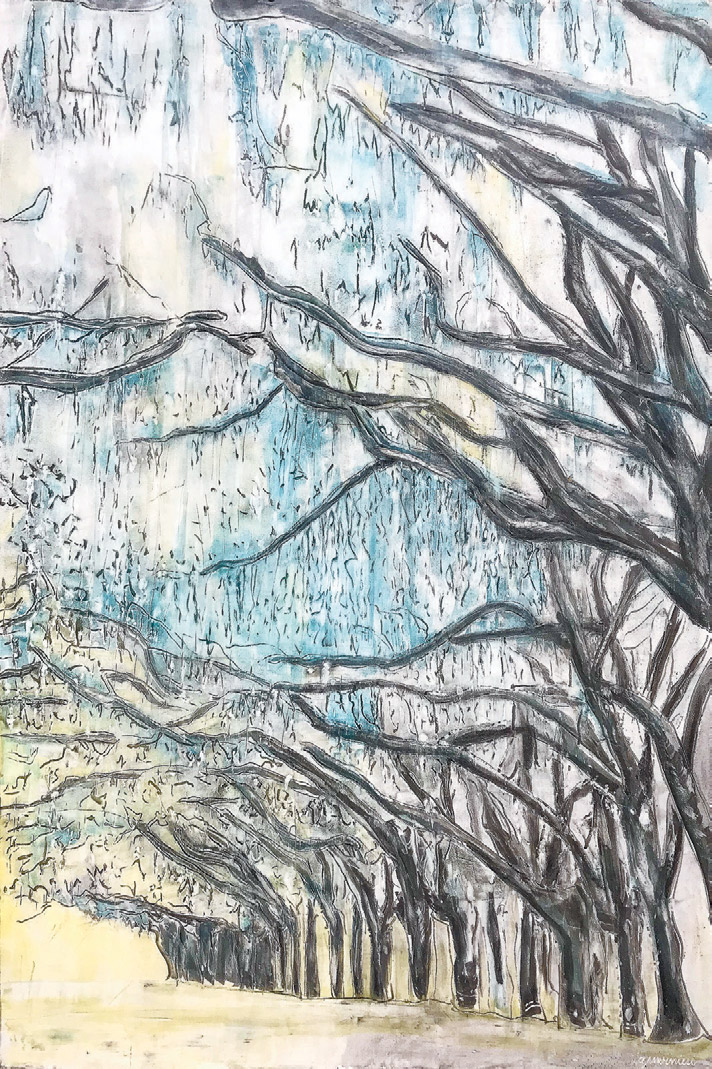
Fountains and Moss in a Savannah Garden
Cal Batchelor is a Savannah native who, on a trip to Italy, meandered in to Studio Iguarnieri and made an immediate connection. Wouldn’t it be fun to bring these guys to Savannah? Everyone proved game. Two weeks of painting would be followed by an art show and silent auction.
Batchelor is an unabashed cheerleader for Savannah. He is a civic leader and a friend to Colleen Smith, which is how the Guarnieri brothers ended up at Cohen’s Retreat. Indeed, Batchelor’s connections and enthusiasm helped draw a crowd the night of the art show. Hundreds showed up, and 18 pieces were sold. The brothers from Italy were not expecting such a reception. The experiment, and two intense weeks of painting, had paid off.
Excursions during those two weeks were limited. Batchelor took the artists one night to dinner at Driftaway Cafe, where the local enthusiasm for firecracker shrimp is deserved. Another night, he organized a wine tasting at a home on the Isle of Hope, where Rodolfo poured Chianti made at his boutique winery outside Florence.
But the day after the show, the artists finally had time to enjoy the city. Batchelor led them on a dizzying tour, stopping first at Tricks Barbecue on Bull St., where the restaurant’s business is conducted outside in the parking lot on a folding table (with a metal box for cash), and where the line for ribs was 20 deep. Nearby is the Vault Kitchen + Market, which offers sushi in a renovated bank. Amid graffiti-covered buildings, other business signs pop up—Back in the Day Bakery, Bull Street Tacos and Wormhole, a dive bar with a popular music scene. Batchelor pointed out the obvious: This is a neighborhood in transition.
Near Forsyth Park, 30 acres in the city’s historic district, the artists stopped for a wholesome lunch, ordering takeout from Brighter Day Natural Foods Market, a large, sun-filled space full of holistic energy. Walking through the park, they witnessed a wedding, the baby-faced groom in dress blues, and were mesmerized by the talents of a jazz musician. Batchelor, nearly sprinting, led the brothers through the Mansion on Forsyth Park, a cheeky boutique hotel filled with hats, abstract art and deer heads. Outside again, the artists dodged several horse-pulled carriages and swept past any number of antique shops to reach the Mercer House (now a museum), the setting for Midnight in the Garden of Good and Evil.
The artists photographed everything, kneeling often, a reminder that a photo improves exponentially when taken from an unexpected angle.
The day ended with a private tour of one of the restored homes in the historic district. The men from Italy, who had marveled for days at American excess—our giant SUVs and our wide grocery aisles, our kitchens just for show—marveled here at the luxury of an expansive climate-controlled wine cellar, which, for now, safeguarded no wine. Outside, the owner had created a lush garden with Gothic architecture and mystery, a fervent tumble of flowers and moss amid the stone walls and a collection of burbling fountains, imported from Europe.
Near the gate, an orange tree bore fruit.
“Is that real?”
Rodolfo was incredulous; it was not the time for ripe oranges.
Inside the kitchen, atop a pristine counter, a dangerously sharp knife slipped through the orange as if it were nothing, and the juices released like a sigh. The orange was light and heavy. It tasted of morning sun and the sweet weight of nightfall. It tasted eccentric, indulged, not real. Yet its peel sat fat and regular and sticky in the hand.
That tree, says the owner, always surprises.
The artists, who had scheduled an excursion to South Beach, decided instead to stay in Savannah. They hoped to participate in a gospel service at First African Baptist Church. And they wanted to witness the St. Patrick’s Day parade, second only in size to the one in New York. To mark the occasion, the water runs green in Forsyth Park.
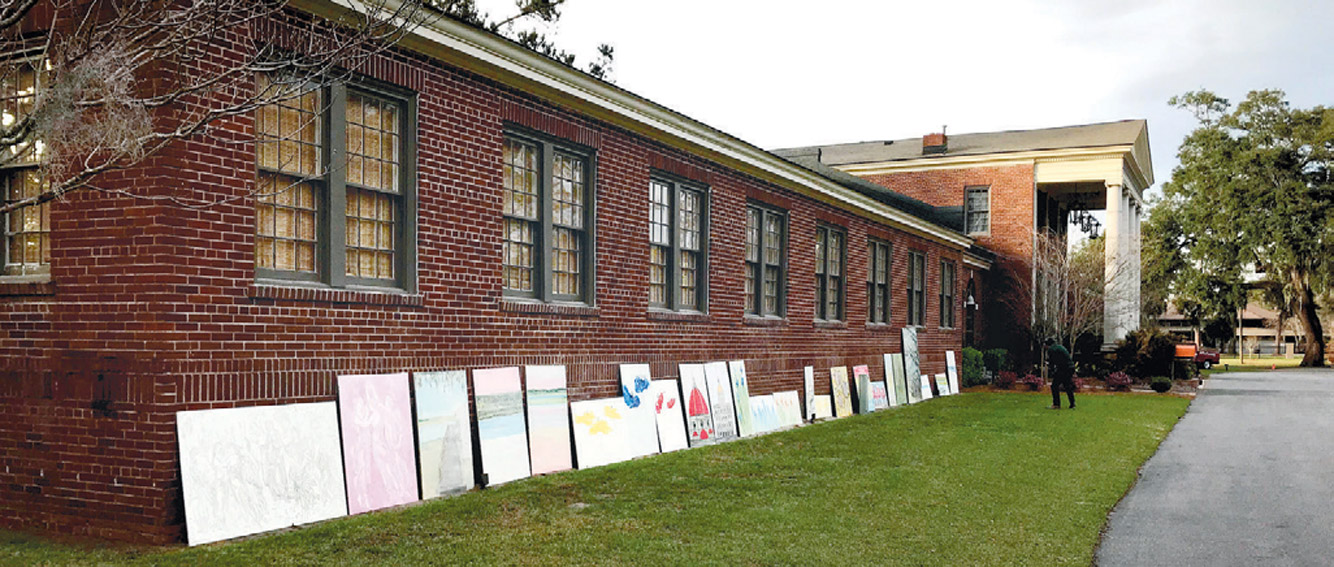
STUDIO IGUARNIERI
Roberto and Rodolfo Guarnieri paint in fresco technique from their studio in Florence, Italy, offering a contemporary interpretation of this traditional and ancient art form. The brothers often paint on location, immersing themselves in the local culture to best convey the energy of place. They have traveled to Moscow and Vancouver. A spring event is planned for the California coast, and a summer event in Australia.
THE ART GALLERY STUDIO IGUARNIERI
39 Lungarno Benvenuto Cellini
Florence, Italy
iguarnieri.it
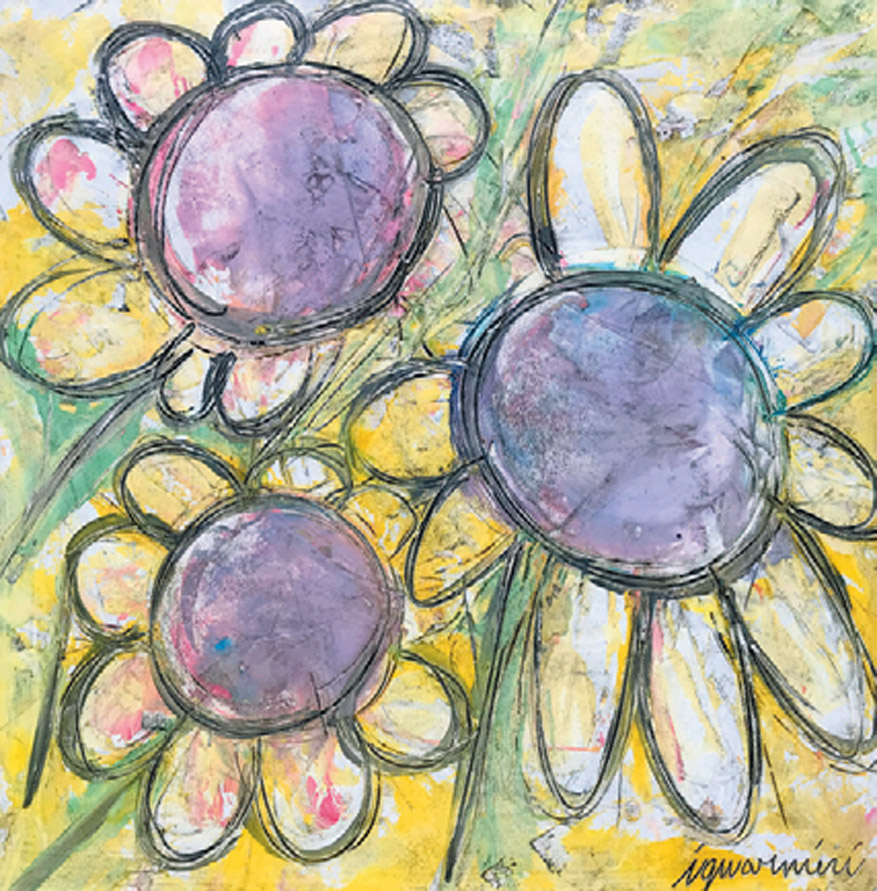
2019 FESTIVALS
Savannah Music Festival
March 28–April 13
savannahmusicfestival.org
Savannah Book Festival
Feb. 14–17
savannahbookfestival.org
St. Patrick’s Day Parade
March 16
savannahsaintpatricksday.com
SCAD Savannah Film Fest
Held in late Oct./early Nov.
filmfest.scad.edu
HOTELS
Cohen’s Retreat
5715 Skidaway Rd.
912.355.3336
cohensretreat.com
Mansion on Forsyth Park
700 Drayton St.
912.238.5158
kesslercollection.com/mansion
RESTAURANTS
Driftaway Cafe
7400 Skidaway Rd.
912.303.0999
driftawaycafe.com
Mabel’s Cupcake Emporium
151 W. Bryan St.
912.341.8014
Trick’s Barbecue
2601 Bull St.
912.655.1068
Vault Kitchen + Bar
2112 Bull St.
912.201.1950
vaultkitchen.co


